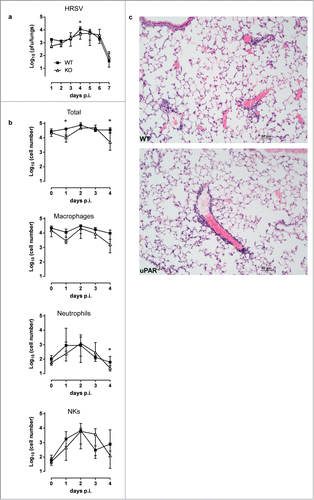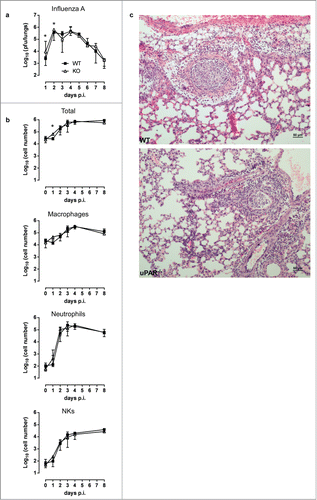Figures & data
Figure 1. Viral titers and lung infiltrate in HRSV infections. (A) WT and uPAR−/− mice were inoculated intranasally with 3×107 p.f.u. per mouse. Lungs were harvested at the indicated dpi and homogenized, after which viral titers were determined. (B) The total number of cells, and the number of macrophages, neutrophils, and NK cells in BAL was determined at the indicated dpi. Day 0 corresponds to uninfected mice. Shown are the medians (interquartile range) of data points from 5 to 10 mice. Comparisons between groups were done using the Mann-Whitney test, ∗ p < 0.05 WT vs uPAR−/−. (C) Lungs were harvested at 1 dpi and stained with H&E. Representative WT and uPAR−/− mice airways are shown.

Figure 2. Viral titers and lung infiltrate in influenza virus infections. (A) WT and uPAR−/− mice were inoculated intranasally with 103 p.f.u. per mouse. Lungs were harvested at the indicated dpi and homogenized, after which viral titers were determined. (B) The total number of cells, and the number of macrophages, neutrophils, and NK cells in BAL was determined at the indicated dpi. Day 0 corresponds to uninfected mice. Shown are the medians (interquartile range) of data points from 5 to 10 mice. Comparisons between groups were done using the Mann-Whitney test, ∗ p < 0.05 WT vs uPAR−/−. (C) Lungs were harvested at 5 dpi and stained with H&E. Representative WT and uPAR−/− mice airways are shown.

Figure 3. Weight loss and survival of mice infected with influenza virus. WT and uPAR−/− mice were inoculated intranasally with 105 p.f.u. per mouse. (A) and (B) Body weight was determined daily and depicted as the percentage of the body weight measured at the time of inoculation. Each line represents an individual mouse and the symbols indicate the days at which the body weight was determined. (C) Mice were monitored daily for survival for 12 days. Mice that had lost more than 25% of their body weight were euthanized and counted as dead animals.

